
The Wii is a home video game console developed and marketed by Nintendo. It was released on November 19, 2006, in North America and in December 2006 for most other regions of the world. It is Nintendo's fifth major home game console, following the GameCube and is a seventh-generation console alongside Microsoft's Xbox 360 and Sony's PlayStation 3.
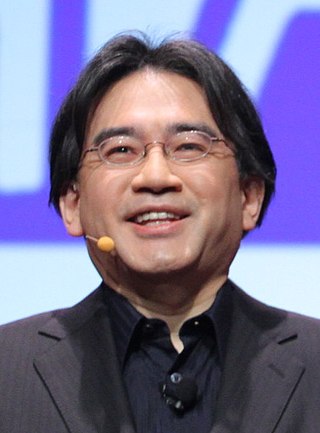
Satoru Iwata was a Japanese businessman, video game programmer, video game designer, and producer. He was the fourth president and chief executive officer (CEO) of Nintendo from 2002 until his death in 2015. He was a major contributor in broadening the appeal of video games by focusing on novel and entertaining games rather than top-of-the-line hardware.

Club Nintendo is a discontinued customer loyalty program formerly provided by Nintendo. The loyalty program was free to join and provided rewards in exchange for consumer feedback and loyalty to purchasing official Nintendo products. Members of Club Nintendo earned credits or "coins" by submitting codes found on Nintendo products and systems, which could be traded in for special edition items only available on Club Nintendo. Rewards included objects such as playing cards, tote bags, controllers, downloadable content, and warranty extensions on select Nintendo products.

A Mii is a customizable avatar used on several Nintendo video game consoles and mobile apps. The name Mii is a portmanteau of "Wii" and "me", referring to them typically being avatars of the players. Miis were first introduced on the Wii console in 2006 and later appeared on the DS, 3DS, the Wii U, the Switch, and various apps for smart devices such as Miitomo. Miis can be created using different body, facial and clothing features, and can then be used as characters within games on the consoles, either as an avatar of a specific player or in some games portrayed as characters with their own personalities. Miis can be shared and transferred between consoles, either manually or automatically with other users over the internet and local wireless communications.

The Japanese multinational consumer electronics company Nintendo has developed seven home video game consoles and multiple portable consoles for use with external media, as well as dedicated consoles and other hardware for their consoles. As of September 30, 2021, in addition to Nintendo Switch, Nintendo has sold over 863.07 million hardware units.
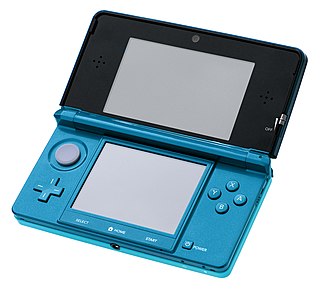
The Nintendo 3DS is a foldable handheld game console produced by Nintendo. The console was announced in March 2010 and unveiled at E3 2010 as the successor to the Nintendo DS. The system features backward compatibility with Nintendo DS video games. As an eighth-generation console, its primary competitor was Sony's PlayStation Vita.
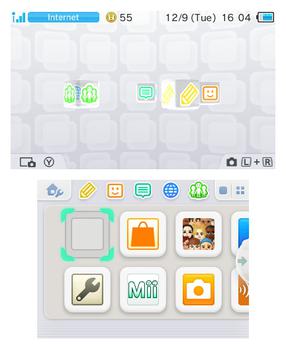
The Nintendo 3DS system software is the updatable operating system used by the Nintendo 3DS handheld system. The Nintendo Switch system software is believed to have evolved from the Nintendo 3DS system software.
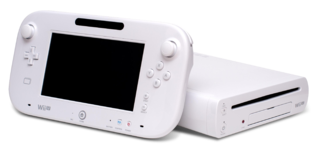
The Wii U is a home video game console developed by Nintendo as the successor to the Wii. Released in late 2012, it is the first eighth-generation video game console and competed with Microsoft's Xbox One and Sony's PlayStation 4.
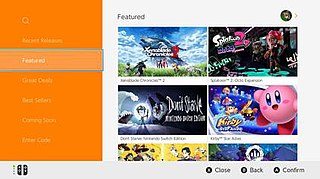
The Nintendo eShop is a digital distribution service for the Nintendo Switch, and formerly available via the Nintendo Network for the Wii U and Nintendo 3DS. The Nintendo eShop was first launched in June 2011 on the Nintendo 3DS via a system update that added the functionality to the HOME Menu. It is the successor to both the Wii Shop Channel and DSi Shop. Unlike on the Nintendo 3DS, the eShop was made available on the launch date of the Wii U, although a system update is required in order to access it. It is also a multitasking application, which means it is easily accessible even when a game is already running in the background through the system software, though this feature is exclusive to the Wii U and the Nintendo Switch. The Nintendo eShop features downloadable games, demos, applications, streaming videos, consumer rating feedback, and other information on upcoming game releases.
The eighth generation of video game consoles began in 2012, and consists of four home video game consoles: the Wii U released in 2012, the PlayStation 4 family in 2013, the Xbox One family in 2013, and the Nintendo Switch family in 2017.
The Nintendo Network is Nintendo's online service which provides online functionality for the Nintendo 3DS and Wii U systems and their compatible games. Announced on January 26, 2012, at an investors' conference, it is Nintendo's second online service after Nintendo Wi-Fi Connection. Former president of Nintendo Satoru Iwata said, "Unlike Nintendo Wi-Fi Connection, which has been focused upon specific functionalities and concepts, we are aiming to establish a platform where various services available through the network for our consumers shall be connected via Nintendo Network service so that the company can make comprehensive proposals to consumers."

The Wii U system software is the official firmware version and operating system for Nintendo's Wii U home video game console. Nintendo maintains the Wii U's systemwide features and applications by offering system software updates via the Internet. Updates are optional to each console owner, but may be required in order to retain interoperability with Nintendo's online services. Each update is cumulative, including all changes from previous updates.

The Nintendo 2DS is a handheld game console produced by Nintendo. Announced in August 2013, the device was released in North America, Europe and Australia on October 12, 2013. The Nintendo 2DS is an entry-level version of the Nintendo 3DS which maintains otherwise identical hardware, similar functionality, and compatibility with software designed for the Nintendo DS and 3DS. However, the 2DS is differentiated by a new slate form factor rather than the clamshell design used by its precursors and by lacking the Nintendo 3DS's signature autostereoscopic 3D display. The 2DS was sold concurrently with existing 3DS models as an incentive to expand the market for Nintendo 3DS games; former Nintendo of America president Reggie Fils-Aimé stated that the 2DS was primarily targeted towards younger players, whom Nintendo had previously advised not to use the 3D functionality on the 3DS due to potential eye health concerns. The Nintendo 2DS's successor, the New Nintendo 2DS XL, was launched in 2017.

Tomodachi Life, known in Japan as Tomodachi Collection: New Life, is a social simulation video game developed and published by Nintendo for the Nintendo 3DS. The game follows the day-to-day interactions of Mii characters as they build relationships, solve problems, and converse with the player. Tomodachi Life is the sequel to the Japan-exclusive Nintendo DS title Tomodachi Collection.

The Nintendo Switch is a video game console developed by Nintendo and released worldwide in most regions on March 3, 2017. Released in the middle of the eighth generation of home consoles, the Switch succeeded the Wii U and competes with Microsoft's Xbox One and Sony's PlayStation 4; it has also competed with the ninth-generation consoles, Microsoft's Xbox Series X/S and Sony's PlayStation 5.

Miitomo was a freemium social networking mobile app developed by Nintendo for iOS and Android devices. The app, Nintendo's first, allowed users to converse with friends by answering various questions, and featured Twitter and Facebook integration. The app was released in March 2016 for iOS and two months later for Android, launching alongside their My Nintendo service. Despite initially being a critical and commercial success, with over ten million downloads worldwide a month after release, its popularity dwindled soon after and it was ultimately discontinued on May 9, 2018.

My Nintendo is a loyalty program provided by Nintendo and the successor to Club Nintendo. The system allows players to earn points from using software or purchasing games, which can then be spent on rewards such as digital games or discounts. The program launched worldwide in March 2016, releasing alongside Nintendo's first mobile app, Miitomo.

Nintendo, a Japanese home and handheld video game console manufacturer and game developer, has traditionally focused on games that utilize unique elements of its consoles. However, the growth of the mobile gaming market in the early 2010s led to several successive fiscal quarters where they were running at a loss. Nintendo, led by president Satoru Iwata at the time, developed a strategy for entering into the mobile games market with development partner DeNA, as a means of introducing their franchise properties to mobile players with a goal of bringing them to buy Nintendo's consoles later. Since 2015, Nintendo has internally developed a number of mobile games, while also publishing games with other developers, including games outside of the initial DeNA partnership. Several of them have been entered the top-downloaded games list on the iOS App Store and Google Play stores, earning over US$100 million in revenue in total.
Nintendo Switch Online (NSO) is an online subscription service for the Nintendo Switch video game console. The service is Nintendo's third generation online service after Nintendo Wi-Fi Connection and Nintendo Network. Following an interim period which began with the launch of the Nintendo Switch where Nintendo offered online multiplayer free of charge and the launch of the Nintendo Switch Online Smartphone App on July 21, 2017, the subscription service officially launched on September 18, 2018.














